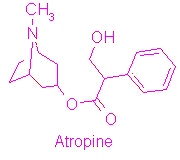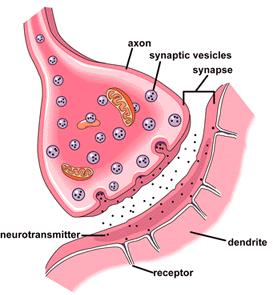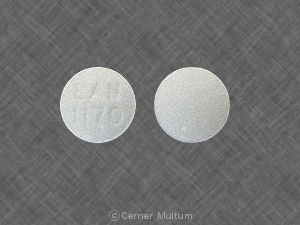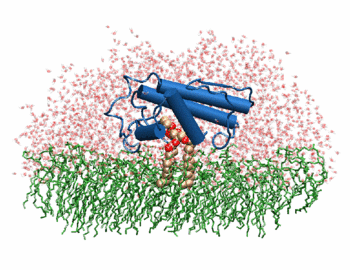Atropine
From Proteopedia
(Difference between revisions)
| Line 1: | Line 1: | ||
<StructureSection load='2bg9' size='450' side='right' scene='' caption=''> | <StructureSection load='2bg9' size='450' side='right' scene='' caption=''> | ||
| - | [[Image:Atropine structure.jpg|thumb|right|1000px|Structure of Atropine]][[Atropine]] is an alkaloid drug derived from levohyscocyamine, a plant compound found in the family Solanaceae<ref> Atropine. Encyclopedia Brittanica. http://www.britannica.com/EBchecked/topic/42015/atropine</ref>. It's chemical name is 8-methyl-8-azabicycolo[3.2.1]oct-3-yl) 3-hydroxy-2-phenylpropanoate, and the most common medicinal form of atropine is atrophine sulfate ((C17H23NO3)2·H2SO4·H2O)<ref> Atropine. New World Encyclopedia. http://www.newworldencyclopedia.org/entry/Atropine </ref>. It is a competitive antagonist of both acetylcholine receptors and phospholipase 2A and has a variety of effects on both humans and animals. | + | [[Image:Atropine structure.jpg|thumb|right|1000px|Structure of Atropine]] |
| + | {{Clear}} | ||
| + | [[Atropine]] is an alkaloid drug derived from levohyscocyamine, a plant compound found in the family Solanaceae<ref> Atropine. Encyclopedia Brittanica. http://www.britannica.com/EBchecked/topic/42015/atropine</ref>. It's chemical name is 8-methyl-8-azabicycolo[3.2.1]oct-3-yl) 3-hydroxy-2-phenylpropanoate, and the most common medicinal form of atropine is atrophine sulfate ((C17H23NO3)2·H2SO4·H2O)<ref> Atropine. New World Encyclopedia. http://www.newworldencyclopedia.org/entry/Atropine </ref>. It is a competitive antagonist of both acetylcholine receptors and phospholipase 2A and has a variety of effects on both humans and animals. | ||
In humans, atropine is metabolized approximately 50%, hydrolyzed to tropine and toropic acid, and the remaining unchanged drug is excreted in the urine<ref> Atropine. New World Encyclopedia. http://www.newworldencyclopedia.org/entry/Atropine </ref>. | In humans, atropine is metabolized approximately 50%, hydrolyzed to tropine and toropic acid, and the remaining unchanged drug is excreted in the urine<ref> Atropine. New World Encyclopedia. http://www.newworldencyclopedia.org/entry/Atropine </ref>. | ||
| Line 21: | Line 23: | ||
[[Image:Synapse.jpg|thumb|left|350px|Synapse]]<ref>Image from: http://www.neurevolution.net/category/history/page/2/ </ref> | [[Image:Synapse.jpg|thumb|left|350px|Synapse]]<ref>Image from: http://www.neurevolution.net/category/history/page/2/ </ref> | ||
| - | + | {{Clear}} | |
==== Inhibition of Acetylcholine Receptors ==== | ==== Inhibition of Acetylcholine Receptors ==== | ||
| - | The image to the left depicts a synapse. A neurotransmitter, such as acetylcholine, goes across the synaptic cleft and binds to its receptor, which can be seen in great detail in the 3D image | + | The image to the left depicts a synapse. A neurotransmitter, such as acetylcholine, goes across the synaptic cleft and binds to its receptor, which can be seen in great detail in the 3D image. Atropine inhibits the effect of acetylcholine by complexing the acetylcholine receptor on the other side of the cleft, subsequently inhibiting the binding of acetylcholine. If atropine does not allow acetylcholine to bind to the acetylcholine receptor, then the effects of acetylcholine are inhibited. This prevents activation of the parasympathetic nervous system and has a wide variety of medical effects. |
=== Medical Uses === | === Medical Uses === | ||
| Line 35: | Line 37: | ||
[[Image:atropine.jpg|thumb|left|350px|Atropine Tablets]] <ref>Atropine Diphenoxylate. http://www.everydayhealth.com/drugs/atropine-diphenoxylate </ref> | [[Image:atropine.jpg|thumb|left|350px|Atropine Tablets]] <ref>Atropine Diphenoxylate. http://www.everydayhealth.com/drugs/atropine-diphenoxylate </ref> | ||
| - | + | {{Clear}} | |
==== Uses in Veterinary Medicine ==== | ==== Uses in Veterinary Medicine ==== | ||
| Line 51: | Line 53: | ||
[[Image:Phospholipase A2.gif|thumb|left|350px|Phospholipase 2A in complex with cell membrane]] | [[Image:Phospholipase A2.gif|thumb|left|350px|Phospholipase 2A in complex with cell membrane]] | ||
| - | + | {{Clear}} | |
In addition to its ability to form complexes with acetylcholine receptors, atropine can also complex with phospholipase A2. Phospholipase A2 is a category of heat-stable enzymes which are involved in cell signaling processes, such as the inflammatory response. <ref>Kumar, Jainendra; Bala, Priti; Vihwal, Preeti. ''Analysis of Interaction of atropine with phospholipase A2 (1th6.pdb)''. Department of Botany and Biotechnlogy, College of Commerce, Patna, India.</ref>. Phospholipase 2A is an upstream regulator of inflammatory processes, and more specifically, it recognizes the sn-2 acyl bond of phospholipids and catalytically hydrolyzes the bond, releasing lysophospholipids <ref> Phospholipase A2. http://www.worldlingo.com/ma/enwiki/en/Phospholipase_A2 </ref>. | In addition to its ability to form complexes with acetylcholine receptors, atropine can also complex with phospholipase A2. Phospholipase A2 is a category of heat-stable enzymes which are involved in cell signaling processes, such as the inflammatory response. <ref>Kumar, Jainendra; Bala, Priti; Vihwal, Preeti. ''Analysis of Interaction of atropine with phospholipase A2 (1th6.pdb)''. Department of Botany and Biotechnlogy, College of Commerce, Patna, India.</ref>. Phospholipase 2A is an upstream regulator of inflammatory processes, and more specifically, it recognizes the sn-2 acyl bond of phospholipids and catalytically hydrolyzes the bond, releasing lysophospholipids <ref> Phospholipase A2. http://www.worldlingo.com/ma/enwiki/en/Phospholipase_A2 </ref>. | ||
This protein is found in mammals, reptile venom, and bacteria. In humans, the overproduction of phospholipase A2 leads to neurologic disorders such as schizophrenia and possibly autism <ref> Phospholipase A2. http://www.worldlingo.com/ma/enwiki/en/Phospholipase_A2 </ref>. An inhibitor of Phospholipase A2, such as Atropine, could be used to treat disorders associated with neural trauma, since Phospholipase A2 increases inflammation which could be potentially complicate neural trauma cases <ref> Phospholipase A2. http://www.worldlingo.com/ma/enwiki/en/Phospholipase_A2 </ref>. | This protein is found in mammals, reptile venom, and bacteria. In humans, the overproduction of phospholipase A2 leads to neurologic disorders such as schizophrenia and possibly autism <ref> Phospholipase A2. http://www.worldlingo.com/ma/enwiki/en/Phospholipase_A2 </ref>. An inhibitor of Phospholipase A2, such as Atropine, could be used to treat disorders associated with neural trauma, since Phospholipase A2 increases inflammation which could be potentially complicate neural trauma cases <ref> Phospholipase A2. http://www.worldlingo.com/ma/enwiki/en/Phospholipase_A2 </ref>. | ||
| - | The image to the | + | The image to the above shows the membrane-bound phospholipase A2 in blue <ref> pla2. http://www.ks.uiuc.edu/Research/smd_imd/pla2/pla2.gif </ref>. |
==== '''Atropine in the Active Site of Phospholipase 2A''' ==== | ==== '''Atropine in the Active Site of Phospholipase 2A''' ==== | ||
Revision as of 07:15, 15 September 2013
| |||||||||||
References
- ↑ Atropine. Encyclopedia Brittanica. http://www.britannica.com/EBchecked/topic/42015/atropine
- ↑ Atropine. New World Encyclopedia. http://www.newworldencyclopedia.org/entry/Atropine
- ↑ Atropine. New World Encyclopedia. http://www.newworldencyclopedia.org/entry/Atropine
- ↑ Atropine. New World Encyclopedia. http://www.newworldencyclopedia.org/entry/Atropine
- ↑ Atropine. New World Encyclopedia. http://www.newworldencyclopedia.org/entry/Atropine
- ↑ Gnagey, Ann L; Seidenberg, Margret; Ellis, John; Site-directed mutagenesis reveals two epitopes involved in the subtype selectivity of the allosteric interactions of gallamine at muscarinic acetylcholine receptors. Molecular Pharmocology, 56:1245-1253, 1999
- ↑ Atropine. New World Encyclopedia. http://www.newworldencyclopedia.org/entry/Atropine
- ↑ Parker, Julie C; Sarkar, Deboshree; Quick, Michael W; Lester, Robin A. Interactions of Atropine with heterologously expressed and native alpha3 subunit-containing nicotinic acetylcholine receptors. British Journal of Pharmacology. 138:5. p801-810. 2009.
- ↑ Image from: http://www.neurevolution.net/category/history/page/2/
- ↑ Atropine. New World Encyclopedia. http://www.newworldencyclopedia.org/entry/Atropine
- ↑ Atropine. New World Encyclopedia. http://www.newworldencyclopedia.org/entry/Atropine
- ↑ Atropine. New World Encyclopedia. http://www.newworldencyclopedia.org/entry/Atropine
- ↑ Atropine. New World Encyclopedia. http://www.newworldencyclopedia.org/entry/Atropine
- ↑ Atropine Diphenoxylate. http://www.everydayhealth.com/drugs/atropine-diphenoxylate
- ↑ Riviere, Jim E. Papich, Mark G. Veterinary Pharmacology and Therapeutics, 9th Edition. John Wiley and Sons, 2009.
- ↑ ATROPINE- ORAL. http://www.medicinenet.com/atropine-oral/article.htm
- ↑ ATROPINE- ORAL. http://www.medicinenet.com/atropine-oral/article.htm
- ↑ Atropine. http://www.rxlist.com/atropine-drug.htm
- ↑ Kumar, Jainendra; Bala, Priti; Vihwal, Preeti. Analysis of Interaction of atropine with phospholipase A2 (1th6.pdb). Department of Botany and Biotechnlogy, College of Commerce, Patna, India.
- ↑ Phospholipase A2. http://www.worldlingo.com/ma/enwiki/en/Phospholipase_A2
- ↑ Phospholipase A2. http://www.worldlingo.com/ma/enwiki/en/Phospholipase_A2
- ↑ Phospholipase A2. http://www.worldlingo.com/ma/enwiki/en/Phospholipase_A2
- ↑ pla2.

Proteopedia Page Contributors and Editors (what is this?)
Lindsey Hayes, David Canner, Alexander Berchansky, Michal Harel, OCA




